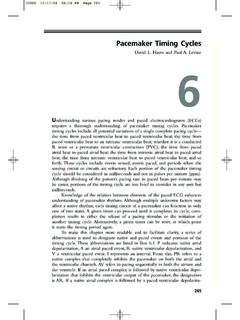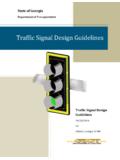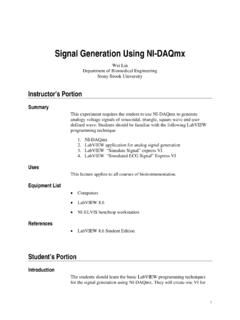Transcription of Get Smart About Reset: Think Local, Not Global - Xilinx
1 WP272 ( ) March 7, 1 2008 Xilinx , Inc. All rights reserved. Xilinx , the Xilinx logo, and other designated brands included herein are trademarks of Xilinx , Inc. All other trademarks are the property of their respective owners. One of the commandments of digital design states,"Thou shalt have a master reset for all flip-flops sothat the test engineer will love you, and yoursimulations will not remain undefined for timeeternal." So, some may be surprised to learn that applying aglobal reset to your FPGA designs is not a very goodidea and should be avoided.
2 Clearly, this is acontroversial issue, so let's take a look at the reasonswhy such a design policy should be Paper: Xilinx FPGAsWP272 ( ) March 7, 2008 Get Smart About Reset: Think local , Not GlobalBy: Ken ChapmanR2 ( ) March 7, 2008 Global Reset Isn't timing -CriticalRGlobal Reset Isn't timing -CriticalWhat are the typical drivers of a Global reset signal ? Press switch: Definitely slow and very undefined timing . Power supply status output: Active for a long period until supply stable. Microprocessor: Pulse tends to be long. In all these cases, it would appear that the reset signal is slow; hence, it would also appear safe to assume that it is not timing -critical.
3 When specifying a timing constraint for your FPGA design, this signal would normally be assigned a long period (low frequency).However, the assumption that the Global reset is not timing -critical is not strictly true, and this assumption statistically becomes a bigger issue as clock rates increase. Although the duration of the reset pulse may be long relative to the clock period and guarantee that all the device flip-flops are reset, the release of the reset signal should be considered to be a timing -critical event. The release of the Global Set/Reset (GSR) within the device is also a Global reset, and just because it is part of the silicon device, it is not infallible.
4 This is also a high fan-out network within the device. While the start-up sequence can be synchronized to a user clock, it cannot be synchronized to all clocks in one design. Devices have multiple DLL/DCM/PLL modules, and each is capable of generating multiple clocks and clock Figure 1, a reset signal is de-asserted at some time between clock edges. The signal then propagates to the various flip-flops. At each flip-flop, the signal should be de-asserted a set-up period before the active clock edge. It is obvious that as the clock rate goes up, the time available to distribute the reset signal goes down.
5 Considering the reset signal is a very high fan-out network, meeting the de-assertion timing requirements is a huge Target - Figure 1 Figure 1:Reset timing Diagram - Asserted Between Clock EdgesClockReset at Device PinReset atFlip-FlopsClock Period (5 ns at 200 MHz)Max Time AvailableSetup Time( ns)Network Skew?WP272_01_010708 Does It Really Matter?WP272 ( ) March 7, 3 RIf the reset is released asynchronously to the clock (often the case), there is no way to guarantee that all flip-flops will be released on the same clock edge, even if the distribution time is less than a clock period (Figure 2).
6 Flip-flops receiving the release of reset at A will be active on the first clock edge, but flip-flops receiving the release of reset at C will not become active until the following clock edge. The flip-flops at B are difficult to define and may even lead to increasing clock rates and the potential distribution skew associated with large devices, it becomes almost inevitable that not all flip-flops are released in preparation for the same clock edge (Figure 3).Does It Really Matter?The good news is that of the time, the timing of the reset release really doesn't matter. With statistics like that, it isn't surprising that most circuits work.
7 However, if you have ever had one of the circuits that doesn t work the first time, then maybe you have encountered one of the cases and have been unlucky enough to have released the reset at the wrong time. X-Ref Target - Figure 2 Figure 2:Reset timing Diagram - Asserted Asynchronously to the ClockX-Ref Target - Figure 3 Figure 3:Reset timing Diagram - High Clock RateClockReset at Device PinReset atFlip-FlopsSetup Time?WP272_02_010708 ABC{ClockReset at Device PinReset atFlip-FlopsWP272_03_0107084 ( ) March 7, 2008 Does It Really Matter?RThe timing of the reset release doesn t matter in the scenario shown in Figure there is a data flow through a pipelined process, it really doesn't matter when the master reset is released.}
8 After a few cycles, the entire pipeline will be operational, and any incorrect data will be flushed out of the system. In fact, there is little point in having a reset at all. Even a simulation will emulate the initial state following configuration, or unknown states will be purged out of the system as valid data inputs are applied. However, Figure 5 shows a scenario in which the timing of the reset release does this example of a simple one-hot state machine, there is a clear potential for failure. If the first flip-flop containing the hot state is released one clock cycle before the second flip-flop, then the hot state will be lost and the state machine will become cold forever.
9 The probability of this happening tends to be reduced by the close proximity of the flip-flops involved (low skew on localized reset network). However unless the set-up time is guaranteed, it could still happen. It is also possible that an encoded state machine may transition into an unexpected state, including an illegal state, if all flip-flops are not released on the same clock cycle. Ultimately, it is the circuits that contain feedback paths that require careful reset considerations. Circuits without feedback really do not need a reset at all. In digital signal processing applications, a finite impulse response filter (FIR) has no feedback.
10 Output samples really have no value until valid data has filled all the taps, so resetting the tap registers achieves nothing. However, an infinite impulse response filter (IIR) contains feedback. If a spurious output sample is generated as a result of an unclean release of reset, then the output samples will be affected for a significant period of time. In the worst case, complete failure of the filter may occur due to Target - Figure 4 Figure 4:Reset for a PipelineX-Ref Target - Figure 5 Figure 5:Reset for a One-Hot State MachineFunctionFunctionFunctionDinResetD outWP272_04_010708 ResetWP272_05_010708 State_1 State_2 State_3 State_4 1 0 0 0 Automatic Coverage of the of CasesWP272 ( ) March 7, 5 RAutomatic Coverage of the of CasesWhen a Xilinx FPGA is configured or reconfigured, every cell is initialized (Figure 6).















